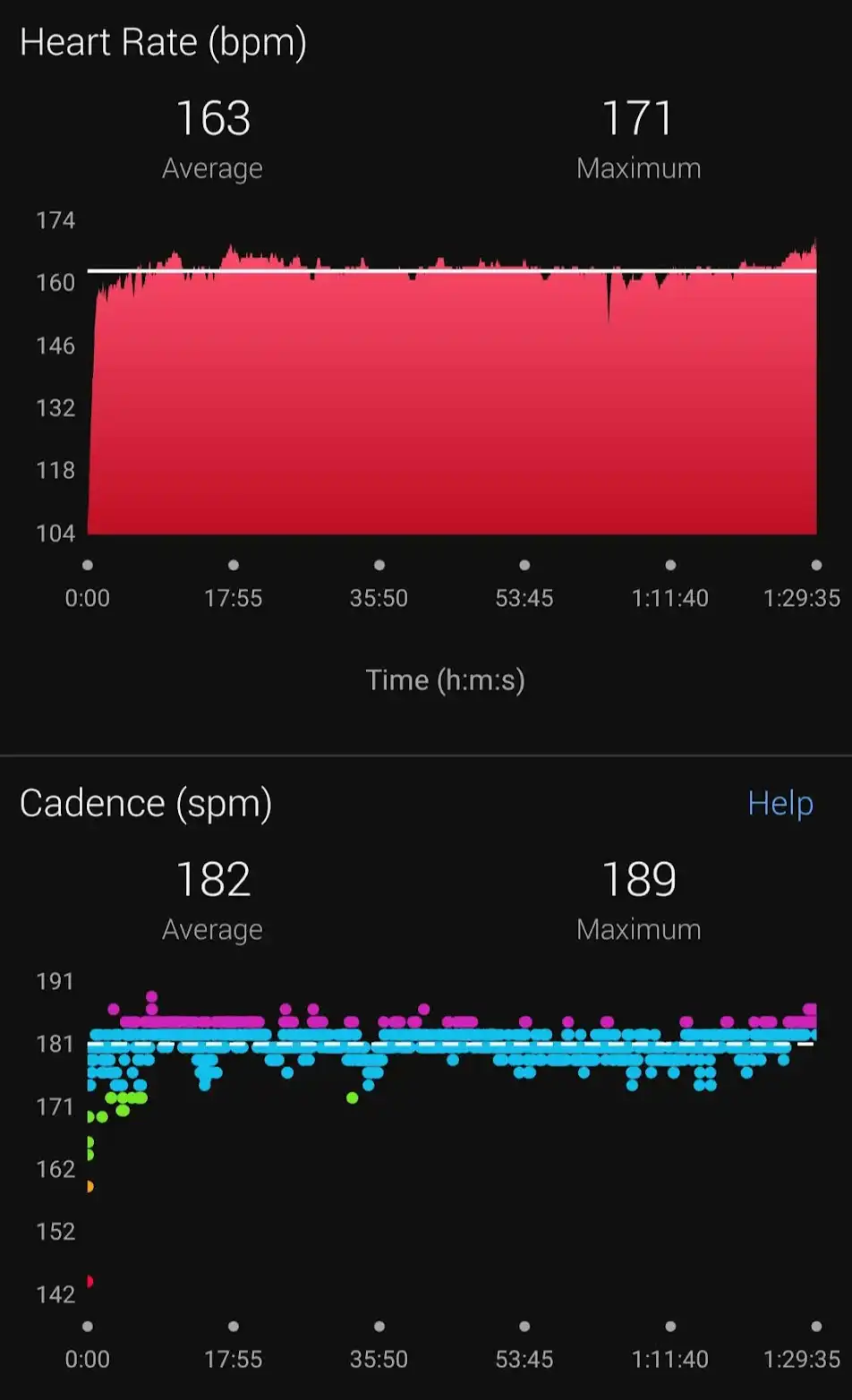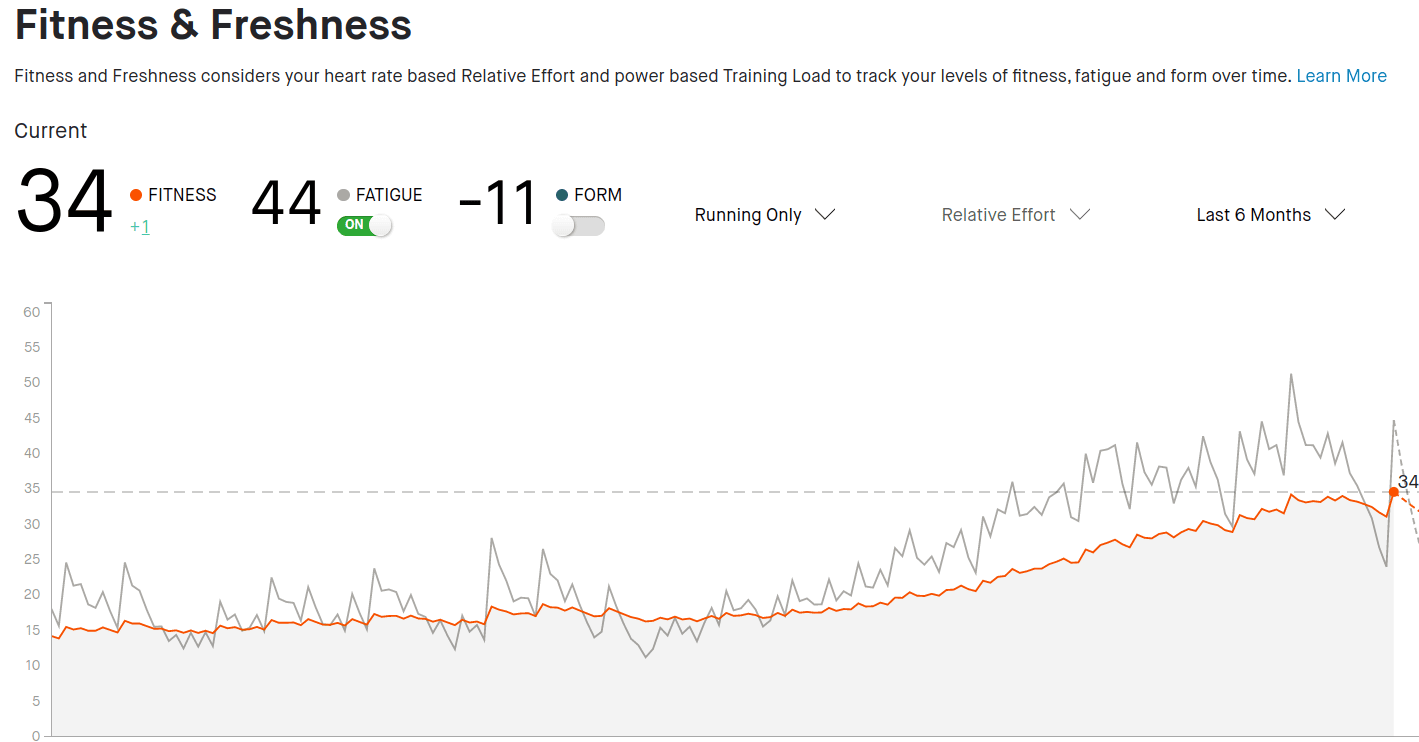Running 2022
clux December 07, 2022 [life] #healthIn an attempt to torture my chair shaped husk of a body, I somehow ran almost 2500km this year. Mostly to see what would happen, but also to take part in the Royal Parks Half Marathon in London.
Milestones
In the process of going up to 70km weeks - something which became routine remarkably quickly - I ended up beating pretty much all of my endurance records:
The Half Marathon was my first longer event and feel I ran it cleanly:

The 3k PB is also a 3200m Cooper test which, heuristically, puts my VO2max at 60. All in all, very pleased with the progress. Particularly getting 10k sub 40 and HM sub 90.
Mileage
Garmin report for the year:
| Month | Mileage | VO2max |
|---|---|---|
| Jan | 117k | 51 |
| Feb | 65k | 52 |
| Mar | 142k | 53 |
| Apr | 144k | 54 |
| May | 190k | 55 |
| Jun | 157k | 54 |
| Jul | 266k | 56 |
| Aug | 322k | 57 |
| Sep | 333k | 58 |
| Oct | 249k | 58 |
| Nov | 349k | 58 |
| Dec | 10k | covid |
Q1/Q2: Volume Building
The year started slow, but increased a little too fast initially without muscle training and ended up spending a lot more time on an elliptical in February. Back in London, when my foot muscles started catching up, I was able to raise the mileage quite a bit come summer (with an average of 60k weekly in July). This gave me confidence to start a pretty ambitious training plan from the end of July.
Q3: Royal Parks
Combined ideas from two generally available training plans:
- AgeUk's Sub 1:30 12w - for general setup, but taking out some of the races
- NSPCC Sub 1:30 14w - for negative split long runs and more thresholds
also incorporated ~two sessions of muscle strength training a week (single leg dead lifts, weighted squats, hungarian squats, heel/soleus raises, plus misc core/oblique strength exercises).
Ended up averaging 71k weekly mileage during this block.
| Week | Mileage | VO2max | Fast % |
|---|---|---|---|
| 1 | 60k | 56 | 6k (10%) |
| 2 | 61k | 56 | 7k (11%) |
| 3 | 66k | 56 | 11k (17%) |
| 4 | 67k | 57 | 14k (20%) |
| 5 | 74k | 57 | 13k (17%) |
| 6 | 79k | 56 | 14k (18%) |
| 7 | 69k | 57 | 20k (29%) |
| 8 | 79k | 57 | 10k (13%) |
| 9 | 77k | 57 | 17k (22%) |
| 10 | 89k | 58 | 24k (27%) |
| 11 | 79k | 58 | 17k (21%) |
| 12 | 57k | 58 | 24k (42%) |
and calculated the following zonal paces:
- 3:32/km -> 17km/h ~= Z6 for mile?
- 3:45/km -> 16km/h ~= Z5 for 5k (18:45)
- 4:00/km -> 15km/h ~= Z4 for 10k (40:00)
- 4:16/km -> 14.1km/h ~= Z3 for HM (1:29:47)
- 5:00/km -> 12km/h ~= Z2
My journal with key-workouts for these weeks:
- 1;
6x1kat ~4:10/km moltemyr, 24k long tromøy, 60km - 2;
6x400mat 3:32/km (aimed for 1:24), 20min fastlysløypa, 21k long, 61km - 3;
4x1Mat 4:05/km greenwhich,1x5kat 4:15 track, 15k long, 66km - 4;
4x1Mat 4:04/km,fartlek ~5k, (swapped out 10k race), 20k long with3k@4:15, 67k - 5:
5x1kat 3:45/km,5kat 4:08, minorhills, 20k long, 74k - 6:
8x500mat 3:42/km,5kat 4:35, 21k long with5kat 4:08, 77k - 7:
8x1kat 4:09/km (stitch),6x1minat 3:29, 10k race at 3:57, 69k - 8:
6x1kat 4:09/km, 10x1min at 3:40/km, 18k long with 1k@4:18, 79k - 9:
2x3k+2x1500at 4:04, 21k long with 8k at 4:15, 77k - 10:
2x3k+2x2kat 4:07, 2x2x400m at 3:30, 21k long with 10k at 4:15, 89k - 11: 5k race attempt, 4x1M at 4:01, 18k long with 6k at 4:15 (big headwind), 79k
- 12 taper week (intensive, but short mileage 60%, muscle monday only, 2k speed, 1k hills), then HM, 57k
By many metrics (Garmin VO2max estimate, Strava fitness), I peaked nicely for the race:

and ended up feeling OK after the race. Got one blood-shot big toenail to show off for a year, but will leave you with the mental image.
Recovery
2 weeks of pretty low effort (40k, 50k), no speed, run every other day.
Q4: Chiang Mai
Second block. 8w. A bit of an impromptu registration for the Chiang Mai Marathon (Half), and a bit of fun that to test how my training translate across continents to a new humid environment. Unfortunately, this block got cancelled near the end.
- 1:
6x1kat 4:00/km, 19k long, 67k - 2:
7x1kat 3:57/km, 21k long, 80k (last in London) - 3:
3.5x1Mat 4:05/km, 700m climb long, 72k (Chiang Mai) - 4:
4x1Mat 4:05/km, 20k long, 85k - 5:
4x1Mat 4:03/km, 22k long, 92k - 6: 8K recovery week,
8kMAF test, and covid 🪦, 38k
Got covid two weeks ahead of the race. First time, but there are ample, warnings about running hard post-covid.
On the positive side, with an ungodly 4AM start for this race and a 90% average humidity (which tanked my running efficiency); having to cancel a difficult masochistic exercise you set purely for yourself is not universally a negative.
Q4: Covid
Unfortunately, it had been one full year since my last (3rd) vaccination shot - and along with probably being hit with one of the Q variants in southeast asia - this disease was not fun. Just as one symptom disappeared another came in to replace it.
While my stress graph on the worst day looked pretty benign (mostly medium stress), my partner's stress graph on Garmin was the worst I have ever seen (with >10 hours of high stress in one day). Still, the fever was pretty bad for me, and am now getting light headed doing easy things 6 days on, so it's definitely not "just a cold".
BMJ has a Graduated Return To Play Guidance Protocol and based on only having some "below-the-neck" systemic symptoms (fever), I am only planning on doing light jogging during the second half of December if/once 🤞 it's possible to:
complete all activities of daily living without excessive fatigue and/or breathlessness and be able to walk on the flat without getting breathless
So, yeah. Use your masks while indoors people. Each time you get reinfected, the risks increase. Hopefully, I can find a way back.
Random Thoughts
Next year
Provided recovery allows; I hope to keep the volume. It is a bit much - and just doing a fraction of it will for sure be enough to just stay healthy - but I kind of want to see how far I can stretch it for a bit longer. It's also made me feel sharper.
Want to train specifically for shorter distances like 1M / 3000 / 5k, even though beating PBs at this points does come with 8+ hours of mandatory training a week and injury risks so how much this is carried on next year is heavily conditional on nothing bad happening - a statement generally not served with good odds in the 2020s.
Not planning on higher distance events like marathons just because of how detrimental it seems to be to your overall immune system and how much recovery you need. My current line of thinking is; why train for 4 months for an event that takes you out of the game for 2-4 weeks? Better find a smooth average that you can sustain.
brain: he says this while planning on beating PBs; requiring the opposite of smooth averages.
Anyway, running has been a fun side-project that's not been software related. It's been interested reading about how professionals train, and seeing effects first hand.
Shoes
The silliest thing about this accessible sport though; is the amount of shoes you burn through. If you run 100k a week, and follow the 500-800k recommendation for max shoe mileage, you'll blast through 5-10 pairs of running shoes a year, costing you somewhere from £500-2000 per year for high end shoes. The £60 I paid to run in Royal Parks was actually worth it just for the 15% off coupon at a running shoe store.
On the plus side, this is temporary. Wish you all good health in 2023.